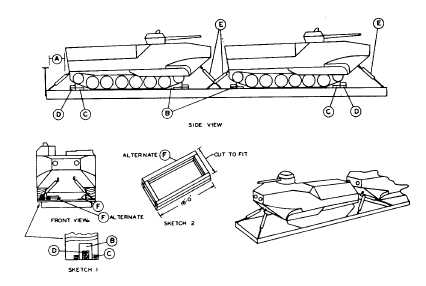Sec. 6-Fig. 78-B (New-10-1973)
LANDING VEHICLE, AMPHIBIAN, (LVTP-7), 60,000 LBS. AND UNDER OR SIMILAR TYPE VEHICLES-
HTTX TYPE OR SIMILAR TYPE FLAT CARS
Item
No. of Pcs.
Description
A
Brake wheel clearance. See Fig. 2, Sec. 1.
B
4 per vehicle.
Block pattern #31. Locate against front and rear of each tread.
C
8
Locate one 2 in. x 4 in. x 20 in. piece of lumber on each side of Items "B". Secure to car floor
with four 30-d nails. (See Sketch 1).
D
4
Place two pieces of 2 in. x 4 in. x 18 in. lumber (doubled) against rear of Items "B". (See Sketch
1). Secure lower piece to floor with four 30-d nails and top piece to lower piece In like manner.
E
4 per vehicle.
1/2 inch alloy chain, proof test 27,500 lbs. Secure chains to tiedown shackles on vehicle. After
tiedown chains are tensioned, they shall be hit sharply with a hammer to relieve any binding
and the tiedown chains retensioned, if necessary. There must be at least one full wrap of
chain around the tensioning device drum. If turnbuckles are used as a tensioning device,
they must be equipped with lock nuts to prevent loosening.
F
4 per vehicle.
Metal cleats, Pattern No. 75. Secure to the car deck against the inside edge of the treads.
One on each side near front and one on each side near rear. Cleats should be secured to
rail car floor prior to loading vehicle on car.
ALTERNATE
F
1 per vehicle.
When metal cleats are not available, a frame-work of 2 in. x 6 in. lumber (doubled) shall be
constructed between the tank treads (See Sketch 2). Frame-work shall consist of four pieces
of lumber 2 in. x 6 in. x 16 ft. long. Locate lower pieces on car floor against inside edge of
each crawler tread. Secure to car floor with twelve 30-d nails. Secure top piece to lower
piece in like manner. Nails should be applied in a staggered pattern. Four pieces of 2 in. x
6 in. lumber cut to fit shall be placed between the longitudinal pieces. Secure lower pieces
to car floor with four 30-d nails. Secure top piece to lower piece in like thinner.
NOTES:
Vehicles may be loaded on rail cars facing in the same direction or in opposite directions.
See General Rules 1, 2, 3, 4, 5, 7, 9, 14, 15 and 19-A for further details.
E-100

